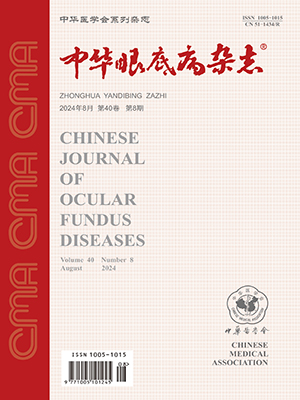| 1. |
Cugati S, Varma DD, Chen CS, et al. Treatment options for central retinal artery occlusion[J]. Curr Treat Options Neurol, 2013, 15(1): 63-77. DOI: 10.1007/s11940-012-0202-9.
|
| 2. |
Mercier J, Kastler A, Jean B, et al. Interest of local intra-arterial fibrinolysis in acute central retinal artery occlusion: clinical experience in 16 patients[J]. J Neuroradiol, 2015, 42(4): 229-235. DOI: 10.1016/j.neurad.2014.02.007.
|
| 3. |
田锦林, 杜亚辉, 罗军, 等. 视网膜中央动脉阻塞: 超选择性眼动脉溶栓与保守治疗的效果比较[J].中国介入影像与治疗学, 2010, 7(4): 367-369.Tian JL, Du YH, Luo J, et al.Comparison of superselective ophthalmic artery fi brinolysis and conservative methods in treatment of central retinal artery occlusion[J]. Chin J Interv Imaging Ther, 2010, 7 (4): 367-369.
|
| 4. |
李逸丰, 魏文斌. 视网膜动脉阻塞的综合治疗[J].中华实验眼科杂志, 2017, 35(1): 93-96. DOI: 10.3760/cma.j.issn.2095-0160.2017.01.020.Li YF, Wei WB. Comprehensive therapy for retinal artery occlusion[J]. Chin J Exp Ophthalmol, 2017, 35(1): 93-96. DOI: 10.3760/cma.j.issn.2095-0160.2017.01.020.
|
| 5. |
Wang R, Qian L, Wang Y, et al. Evaluation of ophthalmic artery branch retrograde intervention in the treatment of central retinal artery occlusion (CRAO)[J]. Med Sci Monit, 2017, 23: 114-120 DOI: 10.12659/MSM.898352.
|
| 6. |
王润生, 钱路, 王毅, 等.眼动脉分支逆行介入溶栓治疗视网膜中央动脉阻塞疗效观察[J].中华眼底病杂志, 2016, 32(4): 377-381. DOI: 10.3760/cma.j.issn.1005-1015.2016.04.008.Wang RS, Qian L, Wang Y, et al. Ophthalmic artery branch retrograde interventional therapy for central retinal artery occlusion[J] Chin J Ocul Fundus Dis, 2016, 32(4): 377-381. DOI: 10.3760/cma.j.issn.1005-1015.2016.04.008.
|
| 7. |
王润生, 雷涛, 王毅, 等. 超选择性眼动脉及选择性颈内动脉溶栓治疗视网膜中央动脉阻塞的疗效观察[J].中华眼底病杂志, 2014, 30(5): 450-453.DOI: 10.3760/cma.j.issn.1005-1015.2014.05.005.Wang RS, Lei T, Wang Y, et al. Super-selective ophthalmic artery or selective carotid artery thrombolytic therapy for central retinal artery occlusion [J]. Chin J Ocul Fundus Dis, 2014, 30(5): 450-453. DOI: 10.3760/cma.j.issn.1005-1015.2014.05.005.
|
| 8. |
王润生, 吕沛霖, 张娅萍, 等. 以尿激酶静脉溶栓为主治疗视网膜中央动脉阻塞115例临床疗效观察[J]. 中华眼底病杂志, 2012, 28(5): 466-471. DOI: 10.3760/cma.i-issn.1005-101 5.2012.05.009.Wang RS, Lyu PL, Zhang YP, et al. Intravenous thrombolysis with urokinase for central retinal artery occlusion in 115 patients[J].Chin J Ocul Fundus Dis, 2012, 28(5): 466-471. DOI: 10.3760/cma.i-issn.1005-101 5.2012.05.009.
|
| 9. |
吴航, 刘大川, 吉训明, 等. 选择性眼动脉溶栓治疗CRAO前后眼底荧光素血管造影的改变[J].眼科新进展, 2010, 30(9): 884-886.Wu H, Liu DC, Ji XM, et al.Changes of fundus fluorescein angiography in patients with central retinal artery occlusion before and after treatment of selective ophthalmic artery thrombolysis[J].Rec Adv Ohtthalmol. 2010, 30 (9): 884-886.
|
| 10. |
吴航, 刘大川, 吉训明, 等, 视网膜中央动脉阻塞选择性溶栓与常规治疗前后眼底荧光血管造影对比[J]. 中国实用眼科杂志, 2010, 30(7): 738-741. DOI: 10.3760/cma.j.issn.1006-4443.2010.07.015.Wu H, Liu DC, Ji XM, et al. Comparison of selective intra-arterial fibrinolysis with conventional treatment in patient with acute central retinal artery occlusion by fundus fluorescein angiography[J].Chin J Pract Ophthalmol, 2010, 30(7): 738-741.DOI: 10.3760/cma.j.issn.1006-4443.2010.07.015.
|
| 11. |
Ahn SJ, Park KH, Ryoo NK, et al. No-reflow phenomenon in central retinal artery occlusion: incidence, risk factors, and clinical implications[J/OL]. PLoS One, 2015, 10(11): 0142852[2015-11-23].http://dx.plos.org/10.1371/journal.pone.0142852. DOI: 10.1371/journal.pone.0142852.
|
| 12. |
王润生, 吕沛霖, 王宾, 等. 视网膜中央动脉阻塞患者视网膜循环时间与中心视力损害的关系[J].中华眼底病杂志, 2007, 23(3): 177-179.Wang RS, Lyu PL, Wang B, et al. Relationship between retinal circulation time and visual loss in patients with central retinal artery occlusion[J].Chin J Ocal Fundus Dis, 2007, 23(3): 177-179.
|




